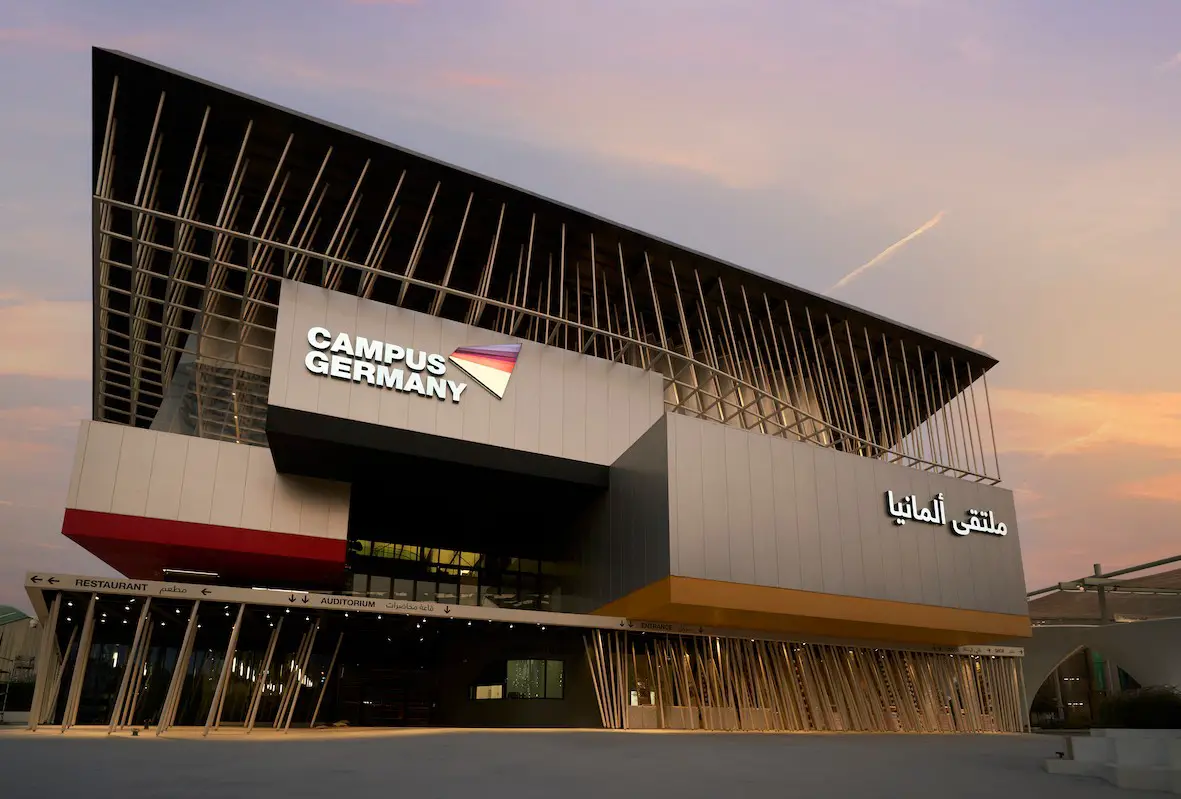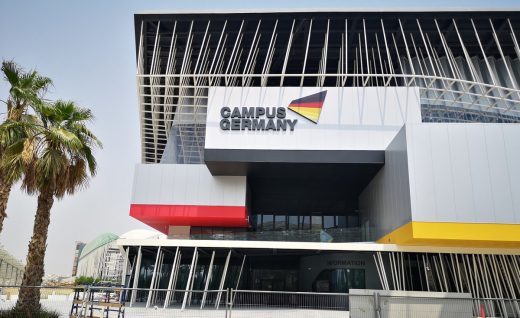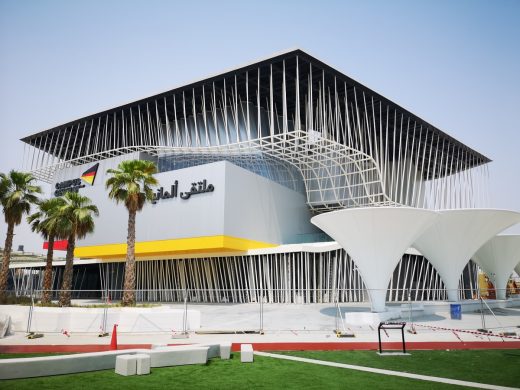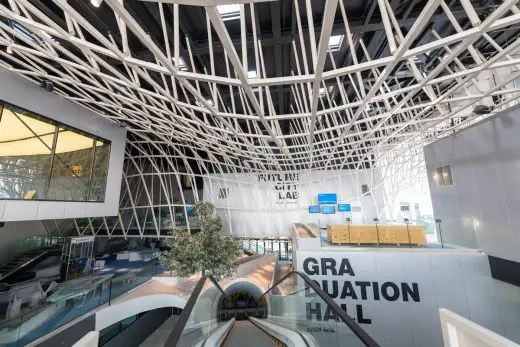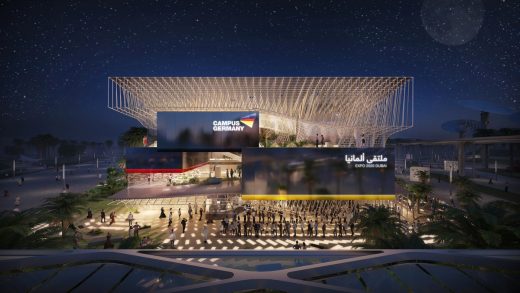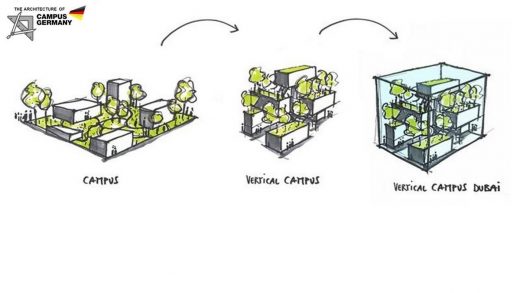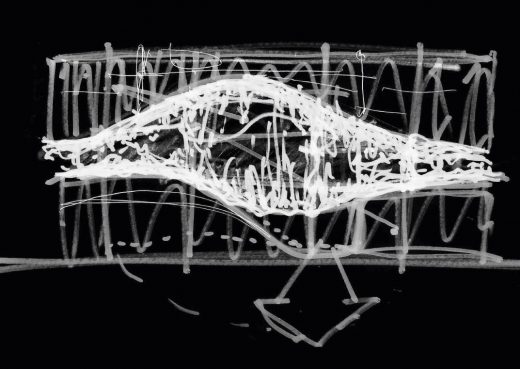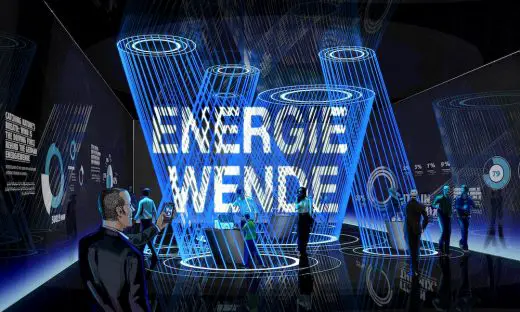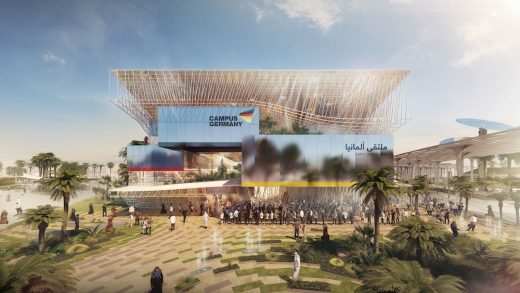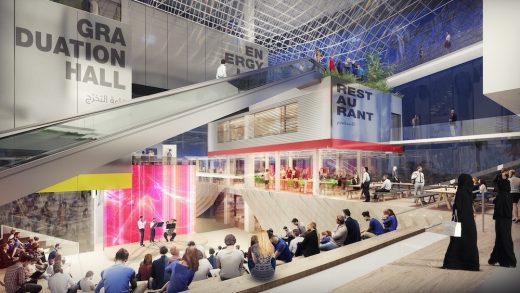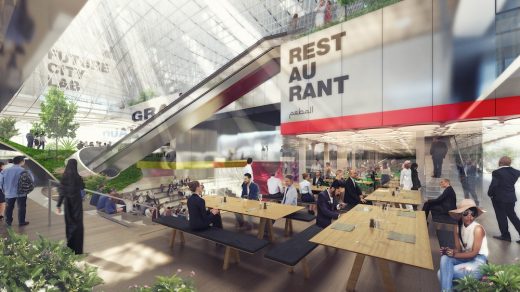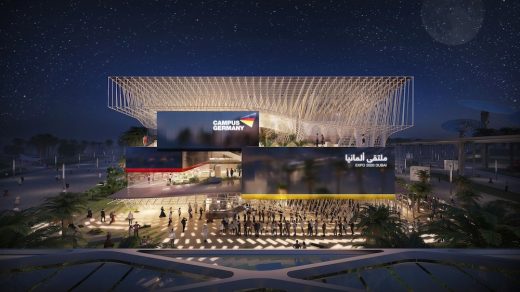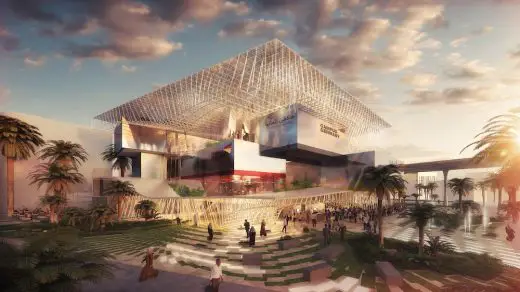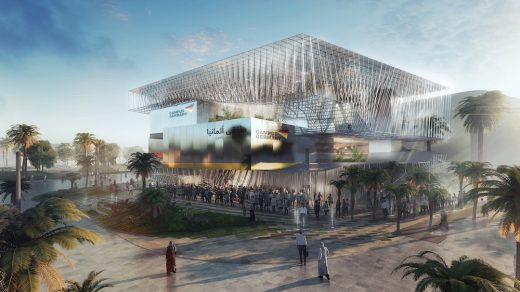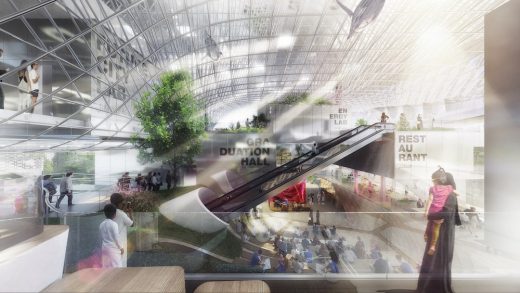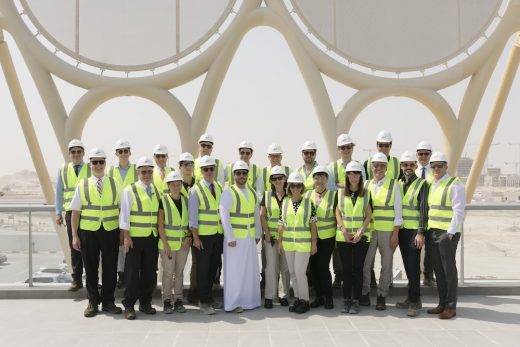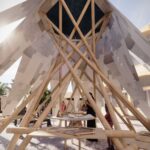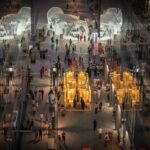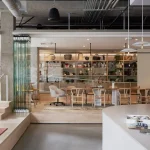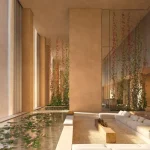2020 Expo Dubai German Pavilion, Event + Exhibition Building Architect, UAE Design Project Images
2020 Expo Dubai German Pavilion Design
ADUNIC: Event + Exhibition Architecture, UAE design by LAVA Architects
post updated 27 September 2021
The German Pavilion @ Expo 2020 Dubai opens on 1 October for six months.
Photo taken in September 2021:
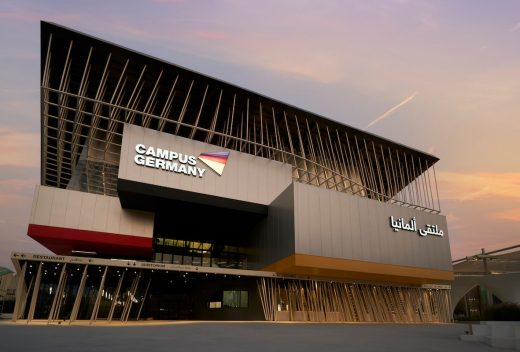
image courtesy of architects practice
2020 Expo Dubai German Pavilion Opening
German Pavilion design embodies message of sustainability
LAVA’s design of the German Pavilion at Expo 2020 Dubai is an ensemble of suspended cubes, a forest of steel poles, covered by a floating roof, opening on 1 October. And behind these visually exciting design elements everything from intelligent use of local climatic conditions to materials reuse to connectedness is sustainable.
“The key question was how to design a temporary exhibition and event space for up to three million visitors in a desert environment that was sustainable. LAVA’s solution linked the Expo theme of connectedness, with our approach of ‘more with less’, with humans interacting with nature and technology at its heart,” said Tobias Wallisser, director of LAVA.
Photos taken in August 2021:
1. BUILDING AS EXHIBIT: Social Sustainability
“The building design is part of the exhibition, a tool to connect people.”
“We wanted to address the Expo motto ‘Connecting Minds, Creating the Future’ and so the team chose to represent Germany as a ‘campus’, an open place for exchange of knowledge, ideas and innovations. Rather than placing the buildings horizontally across a site, three suspended cubes are assembled vertically. This loose, porous stacking of volumes, an ensemble rather than a single form, suggests interconnectedness,” said Christian Tschersich, project director, LAVA.
The positioning of the cantilevered cubes generates a spacious central atrium for gathering and events. At the heart of the visitor experience this covered vertical space visually connects all functional areas with one another, helps with way-finding, creates diverse visual relationships and access points, and assists with management of large visitor numbers.
The visitor route brings people continuously onto terraces (on top of the cubed spaces). They can see their past and future trajectory, engage with other people, and enjoy vistas out to the Expo site. The exhibition spaces inside the cubes (Energy Lab, Future City Lab, and Biodiversity Lab) feature individual immersive experiences, whilst terrace exhibitions invite group interaction.
Rather than a traditional exhibition hall the campus metaphor sees the whole building as an exhibit, not merely a canvas to display, but a tool for connecting people and content, and a place to experience German innovations.
2. BUILDING AS EXHIBIT: STRUCTURAL SUSTAINABILITY
The actual structure is the message.
“We incorporated the principle of sustainability right from the start by using the minimum amount of material to create maximum volume. LAVA’s ‘more with less’,” said Tschersich.
Three cubes were stacked on top of a plinth with other functions (restaurant, pre-show, office, back-ofhouse) formed as an abstract landscape. This created a large volume at the centre, and a roof creates shade and comfort – a technical cloud. A sandwich of three parts: landscape – stacked cubes – roof. People between nature and technology.
The clever positioning of the stacked cubes is driven by local climate and features passive energy-saving
features that reduce the impact of direct sunlight, generate natural shade, decrease the heat load and
optimise the indoor climate. This intelligent creation of shade by the building elements also makes “hybrid”
air conditioning possible. It also referenced the design of the local courtyard house, with closed exterior
facades and rooms oriented towards an inner airspace that open up to each other.
A hybrid facade minimises the sense of building bulk and creates an iconic framing of the space. At the
upper level a dynamic arrangement of 900 vertical steel poles, a forest of trees swaying in the wind, creates
movement. With gradually changing angles they frame the central atrium space and modulate light.
An opaque, trapezoidal single-layer ETFE membrane can be opened and closed, responsive to different
climate conditions during the six-month Expo period, such as sandstorms and cooler days, and minimises
the need for air conditioning. The pavilion’s outer shell also includes 1.5 metres wide glass elements that
can be rotated and opened, allowing the building to breathe.
The visually striking technical cloud roof creates shade and comfort. It allows daylight into the interior
through multiple small openings, similar to sunlight penetrating a forest canopy, creating an ever-changing
visitor experience. Mirror surfaces reflect direct sunlight against the roof skin, a dynamic interplay of light. At
night, a field of LED lights integrated in the ceiling make the building radiate from within.
Resource consumption and the circular economy were also major design drivers and are reflected in
numerous passive and active sustainability features – from Design for Disassembly (DfD) to “Mine the
Scrap”, “grey energy”, sustainable and reusable building materials. The building will be repurposed after the
Expo is finished, with standardised building elements such as steel poles dismantled and reconfigured into
different geometries.
LAVA’s bottom-up approach focussed on visitor comfort, technology in the service of humans. “At LAVA
we’re always looking at the interaction between people and the physical environment they inhabit.
Sustainability requires that environments are adaptable and changeable,” added Wallisser.
The transition from hot exterior to inside was carefully considered. To reduce temperature shock and save
on energy costs the architects designed a transitional space where visitors entering the building, with
lengthy queues, will be cooled by a gentle water mist emanating from steel poles allowing them to gradually
acclimatise. The central atrium is cooled by cold air expelled from the air conditioned exhibition spaces,
thereby reducing energy usage and improving visitor comfort.
“An efficiently stacked volume of space, responding to the local environment with an intelligent climate
management system. This project shows how buildings can be optimised, made intelligent, be
reconfigured, can adapt to changing users, environments, temperatures, acoustics, and light,” said
Alexander Rieck, director, LAVA.
Chris Bosse LAVA Director added: “Functional requirements, visitor experience, climate and environmental
concerns are all resolved thorough this clever multi-performative design.”
Added Wallisser: “Architecture isn’t purely a façade. Of course we wanted the building to be
Instagrammable! But also innovative, thought-provoking, with an effective experiential quality. The hardware
of the building creates a journey for visitors from around the world.”
The concept continues innovation in pavilion design, from London’s Crystal Palace to Germany’s history –
Mies van der Rohe’s German Pavilion at Expo ’29 in Barcelona, Frei Otto at Montreal’s Expo ’67.
The German Pavilion houses a three-level restaurant, VIP spaces for business meetings, an auditorium for
events and performances, plus work spaces for 50 staff. It is located in the sustainability section, close to Al
Wasl Plaza, which forms the heart of the Expo site. Expo 2020 Dubai 1 October 2021 to 31 March 2022 is
divided into three districts: sustainability, mobility and opportunity, with exhibitions from 190 countries.
The Federal Ministry for Economic Affairs and Energy commissioned Koelnmesse GmbH to organise and
run the German Pavilion. The “German Pavilion Expo 2020 Dubai Consortium”, comprising facts and fiction
GmbH and NUSSLI Adunic AG is in charge of concept design, planning and realisation. Facts and fiction is
responsible for content, exhibition and media design, and the pavilion was built by NUSSLI Adunic, with
architecture and spatial design by LAVA.
2020 Expo Dubai German Pavilion UAE – Building Information
NAME OF PROJECT German Pavilion Expo 2020
MINISTRY Federal Ministry for Economic Affairs and Energy (BMWi)
MANAGEMENT Koelnmesse GmbH
LOCATION Dubai, UAE
CLIENT CONSORTIUM facts and fiction with NUSSLI ADUNIC
STATUS Built 2021
SIZE 4,600m2; building height 27 m
PRACTICE CREDITS
LAVA: Tobias Wallisser, Alexander Rieck, Chris Bosse with Christian Tschersich
Project Team: Maria Pachi, Ahmed Rihan, Niklas Knap, Daniele Colombati, Wassef Dabboussi
Competition team: Maria Pachi, Christina Ciardullo, Courtney Jones, Jed Finanne, Benjamin Riess, Joanna
Rzewuska
PARTNERS:
Concept design, planning and implementation – facts and fiction/NUSSLI
Structural engineers – schlaich bergermann partner
Climate – Transsolar
Reuse – Certain Measures
MEP – energytec
Fire – Steinlehner
Light – Kardorff Ingenieure
DRAWINGS © facts and fiction | NUSSLI Group| LAVA
IMAGE CREDITS: © German Pavilion Expo 2020 Dubai / Björn Lauen; NUSSLI Group
Previously on e-architect:
9 Nov 2018
2020 Expo Dubai German Pavilion Building
Design: LAVA Architects
2020 Expo Dubai German Pavilion Building Design by LAVA
A vertical campus of nature and technology
LAVA’s design for the German Pavilion Expo 2020 Dubai is a vertical campus of nature and technology, taking cues from the local architecture and Germany’s history of outstanding lightweight pavilion design. Demonstrating the Expo theme, everything from intelligent use of local climatic conditions to materials reuse to construction is sustainable.
On behalf of the German Federal Ministry of Economy and Energy, Koelnmesse GmbH is responsible for the organisation and operation of the Pavilion, with Consortium German Pavilion EXPO 2020 Dubai facts and fiction GmbH and ADUNIC AG (concept design, planning and implementation) and LAVA (architecture/spatial concepts).
CONCEPT
The airy construction is an efficiently stacked volume of space. A visually striking freeform roof encloses a spacious volume and an intelligent ensemble of interlinked floating cubes housing exhibition and event spaces. The contrast of enclosed air space and immersive exhibition experiences generates an exciting exchange between interior and exterior spaces. The open structure is formed from abstract elements and surprising materials, a composition of repetition and differentiation.
The concept continues German innovation in Expo pavilion design by using new ways of forming space – from Mies van der Rohe’s Barcelona 1929 to Frei Otto’s Montreal 1967 to Fritz Bornemann’s spherical concert hall Osaka 1970.
It also responds to the local climate and references the local courtyard house with closed exterior facade and rooms oriented towards an inner airspace.
ROOF An opaque trapezoidal single-layer ETFE membrane creates a large volume of space with a minimal enveloping surface and highly efficient material. The metallic skin lets light rays into the interior through many small openings, similar to sunlight penetrating forest foliage, creating a continuously changing visitor experience.
Mirror surfaces reflect direct sunlight against the roof skin, a dynamic interplay of light. At night, a field of LED lights integrated in the ceiling make the building radiate from within. Supported by vertical steel cables, the cloudscape roof keeps out the heat and controls light and temperature in the atrium. It reduces production energy, optimises resources by weight savings and creates the technical conditions for a pleasant visitor experience.
ATRIUM A central atrium, a green, open space, connects all visitor areas and allows many surprising perspectives. The composition of exhibition spaces, event area and restaurants are interwoven through these manifold visual relationships. The pavilion tour brings visitors continuously onto the terraces of the open atrium, providing an overview of their location within the pavilion, the variety of topics and social interaction with other visitors. Native German plants hang from the terraces and roof creating comfort in the atrium and special light.
LAYOUT The vertical campus courses between a landscaped layer on the lower two levels and the cloud roof. The rear east is a vertical backbone with technical facilities and service functions, and the front western side houses exhibition and restaurant spaces layered horizontally. The sequence of stacked seemingly floating building elements is a journey through the campus learning experience – from enrolment to learning curriculum to graduation. The ‘laboratories’, purposedesigned for exhibition, performance and dining, are grouped around the atrium.
SUSTAINABILITY
The design continues LAVA’s philosophy of sustainability at multiple levels, a strong visual symbol and example for visitors, by:
1. Material-optimised construction based on nature’s geometries.
2. Passive energy saving measures applied at the very outset in the design – for example the stacked building elements not only trap vertical airspace, but also minimise direct sunlight creating a sheltered atrium with minimal solar input and optimised climate.
3. Intelligent arrangement creates different spatial situations, not through complex technology, but rather through digitised production processes.
4. Minimisation of grey energy and operational energy.
5. Graduated climatic zones of individual areas allow reduced energy use, whilst supporting the diversified room experience for visitors.
6. Reuse of building parts and materials – using algorithms to reduce waste.
7. Barrier-free access.
Tobias Wallisser, LAVA director, said: “It exemplifies LAVA’s work with natural geometries to generate efficient and beautiful structures and space through intelligent skins using integrative technology and cutting edge materials. And how buildings perform at many sustainable levels – environmental, structural and social.”
Alexander Rieck, LAVA director said: “The project continues LAVA’s expertise working in desert environments (Masdar Plaza UAE and more recently the university masterplan and headquarters for KACST in Saudi Arabia.) The integration of local climatic conditions, innovative use of recyclable materials and ground-breaking climate control technologies demonstrate how one can build and operate in harmony with the location.”
LAVA Director Chris Bosse said: “The challenge is: how does a country physically represent itself in an exhibition like the Expo? World exhibitions give a glimpse of the future from the perspective of their time. Our pavilion design shows Germany’s contribution to that view of the future. The sequence of different spatial areas encourages visitors to have fun whilst learning.”
“The building itself is part of the exhibition, a tool for connecting people and content, both a model of sustainability and a place to discover German innovations and solutions on this important topic,” added Christian Tschersich, Project Manager at LAVA.
The Expo 2020 theme is “Connecting Minds, Creating the Future” and it runs from 20 October 2020 to 10 April 2021.
IMAGE CREDITS: (c) facts and fiction | adunic | LAVA
2020 Expo Dubai German Pavilion Building images / information received 081118
20 Aug 2018
2020 Expo Dubai German Pavilion
Design: LAVA Architects
2020 Expo Dubai German Pavilion
Cologne, August 2018 – EXPO 2020: Cologne creativity and Swiss construction expertise for Dubai
facts and fiction and ADUNIC win German Pavilion bid
In a key milestone on the road to EXPO 2020 Dubai, Germany has decided who is to design and build the German Pavilion. The bid was won by a consortium comprising Cologne-based agency facts and fiction and Swiss construction company ADUNIC, with architecture to be designed by Berlin firm LAVA.
While facts and fiction will be responsible for content, exhibition and media design, building the pavilion will be ADUNIC’s job. facts and fiction specialises in spatial communication and ADUNIC are specialists in the construction of temporary buildings. As well as matching both companies’ profiles, the brief reflects the essence of Expos, which are all about giving those who visit during the short six months of the event an Expo experience that stays with them forever. “We’re delighted to have won the German Pavilion contest,” says Dietmar Jähn, a managing director at facts and fiction, commenting on the selection committee’s decision. “It’s a dream come true and a great honour for us to have our concept chosen to represent Germany at the EXPO in Dubai.”
An EU-wide notice of tender was published back in September 2017, inviting teams to apply to design the concept and to plan and build the interior and exterior of the German Pavilion for EXPO 2020 Dubai. The brief also included the technical management of the pavilion during the World Expo from 20 October 2020 to 10 April 2021 and the dismantling of the pavilion after the event.
Initially, applicants were asked to draw up a high-level concept. This was followed by a second phase, in which a 17-member selection committee (made up of representatives of various federal ministries, trade/industry associations and experts on Expo and regional matters) chose five interdisciplinary teams to put through to the next phase – the design of a detailed concept for the German Pavilion.
“The awarding of the contract to facts and fiction and ADUNIC marks the end of a ten-month process. We are happy that things can now progress and building work can start on our plot in Dubai next year,” says Dietmar Schmitz from Germany’s Federal Ministry for Economic Affairs and Energy. As Commissioner General of the German Pavilion, Mr Schmitz is responsible for the country’s presence in Dubai. He is head of the “Policy on fairs and exhibitions, expo participations” division at the Ministry and has been involved in World Exhibitions across the globe over the course of many years.
The two partners in the German Pavilion consortium are no newcomers to Expo either. facts and fiction designed the Monaco and Kazakhstan pavilions in Milan in 2015 as well as the German presence at EXPO 2012 in the Korean city of Yeosu. ADUNIC built a number of the pavilions in Milan in 2015.
New to Expo is LAVA, an international team of architects with offices in Berlin, Stuttgart and Sydney and a wealth of experience, having worked on a wide variety of major projects around the world. In the Middle East, for instance, LAVA helped plan the Masdar eco city in Abu Dhabi and also designed the architecture for the King Abdulaziz City for Science and Technology in Riyadh, Saudi Arabia.
facts and fiction and ADUNIC were selected on the basis of the tender criteria. The main requirement was to take the EXPO theme of “Connecting Minds, Creating the Future” and the sustainability subtheme chosen by Germany and translate them into a pavilion concept that will grasp visitors’ interest and hold it from start to finish while also creating a seamless marriage between the pavilion’s architecture and its content.
But all has not yet been revealed. The concept will not be presented in Germany until a press conference at Koelnmesse in Cologne on 4 September 2018, to be followed by a second press conference at the Steigenberger Hotel Business Bay in Dubai on 19 September. Koelnmesse is the company that will be organising and running the German Pavilion at the 2020 World Expo in Dubai on behalf of the Federal Ministry for Economic Affairs and Energy.
For more information, visit www.expo2020germany.de and on the YouTube channel
2020 Expo Dubai German Pavilion images / information received 200818
Location: Jebel Ali, Dubai, UAE
Dubai 2020 Expo Pavilions
Dubai 2020 Expo Pavilions
Design: Santiago Calatrava, Foster + Partners, BIG and Grimshaw Architects
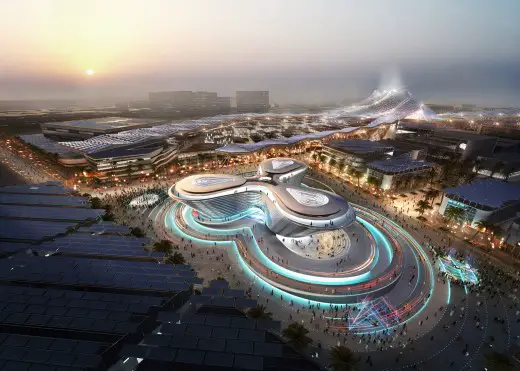
Dubai 2020 Expo Pavilions
Design: METAFORM Architects
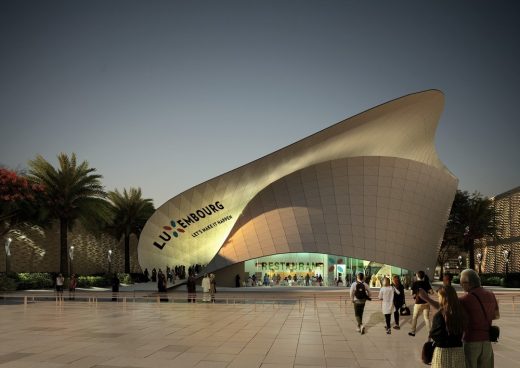
image courtesy of architects
2020 Expo Dubai Luxembourg Pavilion Building
Sustainability Pavilion for Expo 2020 Dubai
Design: Grimshaw Architects
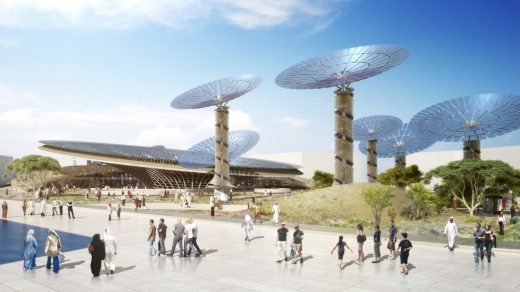
image courtesy of architects
Sustainability Pavilion for Expo 2020 Dubai
Dubai World Expo 2020 Masterplan
Design: HOK / Populous
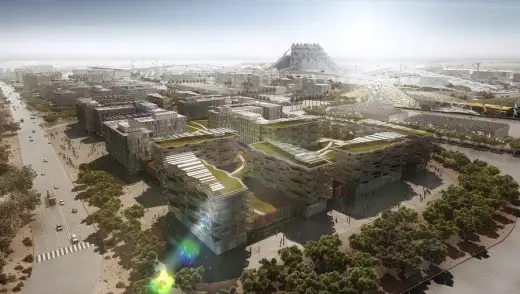
Dubai World Expo Masterplan by HOK / Populous
UAE Architecture
Burj 2020 Dubai Tower in UAE
Architects: RNL Design
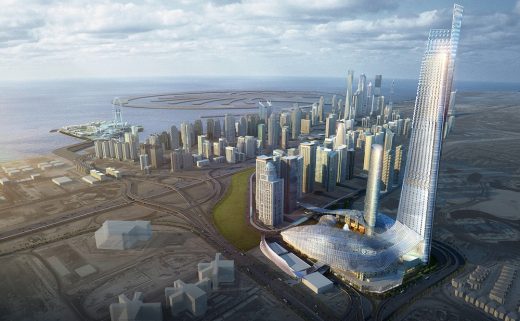
photo courtesy of architects
BURJ 2020 Dubai Building
Hyperloop Pods and Portals
Design: BIG-Bjarke Ingels Group
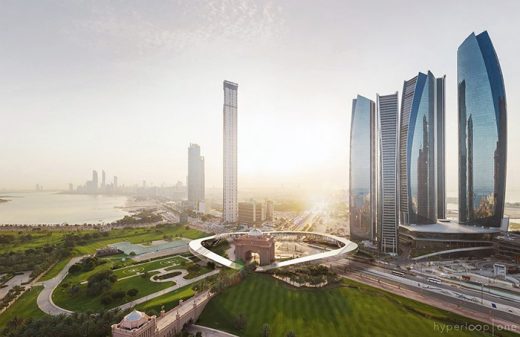
image from architects
Hyperloop Pods and Portals in Dubai
Architecture Tours Dubai by e-architect
Comments / photos for the 2020 Expo Dubai German Pavilion page welcome
Website: 2020 Expo Dubai German Pavilion

